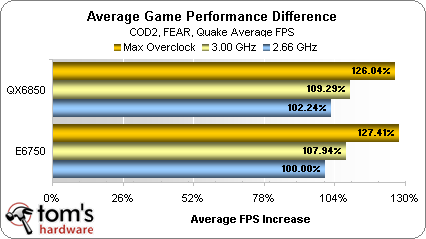Extreme FSB 2: The Quad-Core Advantage?
Performance Summary
The Core 2 Duo E6750 was more overclockable than the Core 2 Extreme QX6850, but not by the large margin we'd thought was possible. We'd hoped that a few changes in settings would allow an approximation of Q6600 capability, at least for Q6600's that have the same stellar G0 core stepping revision. This obviously didn't happen. Still, we can prove the gaming advantage goes to the cheaper dual-core, can't we?
At its maximum clock speed, the better-overclocking Core 2 Duo E6750 edges out the Core 2 Extreme QX6850 in games. At other speeds, the QX6850 wins. Gamers will be happy to see how close these two are, as it justifies buying the cheaper processor and spending the huge amount of leftover cash on something more important - like a second $600 graphics card!
Many applications are coded to use multiple cores, but a few are still limited to one or two threads. We expect a fairly large average gain for the four-core processor, but how well did it do in a maximum-overclocking race?
At 2.66 GHz, four cores beat two by around 36%. The difference narrows a bit when both processors are overclocked to extremes, which we expected because the Core 2 Duo E6750 overclocks higher than the Core 2 Extreme E6850.
Some synthetic benchmarks test raw CPU power, so we can expect to see the greatest four-core advantage here.
At 2.66 GHz, the Core 2 Extreme is ahead of the Core 2 Duo by a whopping 86%. Once again, the four-core advantage narrows a little at maximum CPU speed, due to the dual-core's better overclocking capability.
Get Tom's Hardware's best news and in-depth reviews, straight to your inbox.
Current page: Performance Summary
Prev Page Synthetic, Continued Next Page Performance Summary, Continued


